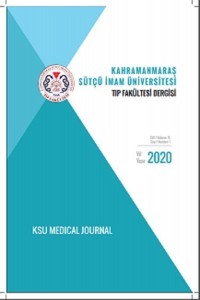Okul Öncesi Dönem Down Sendromlu Çocuklarda D Vitamini Eksikliği
down sendromu, vitamin d, okul öncesi
Vitamin D Deficiency in Preschool Children with Down Syndrome
down syndrome, vitamin d, preschool,
___
- 1. Çalışkan Özçelik D, Koçer H, Kasım İ, Şencan İ, Kahveci R, Özakara A. D vitamini- Derleme. Turkish Medical Journal 2012:6(2)
- 2. Holick MF. Vitamin D deficiency. N Eng J Med 2007;357:266-81.
- 3. de Graaf G, Buckley F, Skotko BG. Estimation of the number of people with Down syndrome in the United States. Genet Med 2017;19:439-47.
- 4. Hawli Y, Nasrallah M, El-Hajj Fuleihan G. Endocrine and musculoskeletal abnormalities in patients with Down syndrome. Nature Reviews Endocrinology, 2009:5(6); 327-34.
- 5. Wiseman FK, Alford KA, Tybulewicz VL, Elizabeth M C Fisher. Down syndrome- recent progress and future prospects. Human Molecular Genetics, 2009:1(18):75-83.
- 6. Reza SM, Rasool H, Mansour S, Hemayattalab A. Effects of calcium and training on the development of bone density in children with Down syndrome. Research in developmental Disabilities. 2013;34(12):4304-09.
- 7. Ferry B, Gavris M, Tifrea C, Serbanoiu S, Pop AC, Bembea M et al. The bone tissue of children and adolescents with Down syndrome is sensitive to mechanical stress in certain skeletal locations: a 1-year physical training program study. Research in Developmental Disabilities, 2014;35(9):2077-84.
- 8. Wahl DA, Cooper C, Ebeling PR, J Hilger, K Hoffmann, R Josse, J A Kanis et al. A global representation of vitamin D status in healthy populations. Archives of Osteoporosis, 2012;7(1-2):155-72.
- 9. Pludowski P, Grant WB, Bhattoa HP, Bayer M, Povoroznyuk V, Rudenka E et al. Vitamin D status in central Europe. International Journal of Endocrinology, 2014;2014:589587. doi: 10.1155/2014/589587.
- 10. M. F. Holick. Vitamin D status: measurement, interpretation, and clinical application. Annals of Epidemiology, 2009;19(2):73-8.
- 11. Holick MF. Resurrection of vitamin D deficiency and rickets. The Journal of Clinical Investigation, 2006;116(8):2062-72.
- 12. Han SS, Kim M, Kim H, Lee SM, Yun Jung Oh, Lee JP et al. Non-Linear relationship between serum 25 Hydroxyvitamin D and hemoglobin in Korean females: The Korean National Health and Nutrition Examination Survey 2010-2011. PLoS One 2013;8:e72605. 2013 Aug 28;8(8):e72605. doi: 10.1371/journal.pone.0072605.
- 13. Shin JY, Shim JY. Low vitamin D levels increase anemia risk in Korean women. Clin Chim Acta 2013;421:117-20.
- 14. Specker BL, Valanis B, Hertzberg V, N Edwards, R C Tsang. Sunshine exposure and serum 25- Hydroxyvitamin D concentrations in exclusively breast-fed infants. J Pediatr. 1985;107(3):372-6.
- 15. Tezel B, Aydın Ş. T.C. Sağlık Bakanlığı, Halk Sağlığı Genel Müdürlüğü Bebek, Çocuk, Ergen İzlem Protokolleri. Ankara-2018 p:171.
- 16. N Doğan, A Colak, N Güden, F Üstüner. Vitamin D deficiency in children in Aegean Region in Turkey. Cumhuriyet Medical Journal 2015;37(1):17-22
- 17. Kartal Ö, Gürsel O. The Relationship Between Serum Vitamin D Level, Anemia, and Iron Deficiency in Preschool Children. Haydarpasa Numune Med J 2019;59(3):220-23
- 18. Stagi S, Lapi E, Romano S, Bargiacchi S, Brambilla A, Giglio S et al. Determinants of Vitamin D Levels in Children and Adolescents With Down Syndrome. Int J Endocrinol. 2015;2015:896758. doi: 10.1155/2015/896758.
- ISSN: 1303-6610
- Yayın Aralığı: Yılda 3 Sayı
- Başlangıç: 2004
- Yayıncı: Kahramanmaraş Sütçü İmam Üniversitesi
Habituel Abortus Olan Gebelerde Homosistein Folik Asid ve Vit B12 Seviyelerinin Değerlendirilmesi
Cerrahi Geçiren Hastaların Erken Dönem Konfor Düzeyleri
Nursevim AYDINGÜLÜ, Sevban ARSLAN
Fibromiyalji Hastalarında D Vitamini Eksikliğinin Fiziksel Semptomlara Etkisinin İncelenmesi
İhsan KARABULUT, Deniz KOCAMAZ, Begümhan TURHAN
Yanık Yoğun Bakım Ünitesi Hastalarında Sağlık Hizmeti İlişkili Enfeksiyonlar
Sevil ALKAN, Özgür GÜNAL, Süleyman KLIÇ, Alper TAHMAZ, Alper CEYLAN
Menopozal Semptomlar ve Etkileyen Faktörler: Türk Kadınları Örneği
Evşen NAZİK, Sevban ARSLAN, Seda KARAÇAY YIKAR, Hakan NAZİK, Funda ÖZDEMİR, Serap EJDER APAY
Tugay TARTAR, Ünal BAKAL, Mehmet SARAÇ, Yeşim EROĞLU, Ahmet KAZEZ
Cengizhan YAVUZ, Gökçe GİŞİ, Aykut URFALIOĞLU, Ömer Faruk BORAN, Bora BİLAL, Gözen ÖKSÜZ, Mahmut ARSLAN, Hafize ÖKSÜZ, Hüseyin YILDIZ, Şeyma BAHAR
Palyatif Bakımda Nörolojik Hastalıklarda Hemşirelerin Bilgisi Yeterlimi?
Gülhan SARIÇAM, Kadriye KAHVECİ, Doğan AKDOĞAN
